Introduction
|
| Bellini Duct Carcinoma is known as a rare variant of renal cancer originating from the Collecting tubules, unlike all other renal tumors which originate from the proximal tubules. |
| The first series of collecting duct epithelial tumors was discussed by Manzilla-Jimenez in 1976 [1], Although Mason [2] had previously described this different type of renal tumor in 1955. Fleming and Lewi [3] defined the diagnostic criterion and established it as a different diagnostic entity originating from the renal medulla. |
| These sorts of tumors present an early dissemination and fatal clinical course in addition to histological characteristics similar to Urothelial tumoral types. |
| Chemotherapy schemes similar to those used for Urothelial tumors being employed, we present two cases of this disease arising at our Hospital for reviewing the currently-existing literature concerning this disease. |
Case Series
|
| We searched the database of Anatomo-Patological Service and founded two cases of Bellini Duct Carcinoma which were reviewed. |
|
Case Number 1
|
| A 54 years old male patient with medical history of smoking and Ischemic heart disease underwent a Nephrectomy as a result of a renal mass, being diagnosed with Bellini Duct Carcinoma. Two years later, he presents lung, bone and lymph node metastasis and a lung FNAB (fine-needle biopsy aspiratory) being performed, confirming the recurrence. |
| The patient started chemotherapy treatment as per Carboplatin (AUC 3) - Gemcitabine (1000 mg/m2) scheme because of moderate renal failure secondary to previous Nephrectomy. Two cycles were administered but he underwent a quick thoracic spread which required hospitalization due to uncontrolled pain. |
| The patient received a new chemotherapy scheme with Docetaxel 75 mg/m2 ,undergoing exclusively one cycle. Thereafter he showed a suddenly deterioration of his overall condition and death occurred three months following the relapse due to respiratory complications and two years after the diagnostic of renal cancer. |
|
Case Number 2
|
| A 49 years old male with no prior medical history except of Grade 1 Obesity who came to the Emergency department due to symptoms of breathlessness and fever |
| Hypoxemic respiratory failure and a chest Rx (Figure 1) compatible with Bilateral pneumonia being objectified, as a result of which he was admitted to Internal Medicine with empiric antibiotic coverage for severe Community-Acquired Pneumonia and oxygen therapy. |
| The patient did not progress satisfactorily, the hypoxemia continuing and showing no Improvement in the chest X-ray as a result of which the decision was made to run a CT TAP (Thoracicabdominal- pelvic scan) (Figures 2-4), showing lesion compatible with right kidney Tumor infiltrating renal parenchyma with retroperitoneal, preaortic and retrocaval metastatic lymph nodes compressing and infiltrating the inferior cava with thrombosis of right renal vein. |
| Also showing lung metastasis with wedge-shaped airspace consolidations and peripheral distribution in relation to pulmonary infarcts |
| A right renal mass Macro biopsy was performed, showing a histological diagnostic compatible with Collecting duct Carcinoma (Figure 5). |
| The patient was placed under care in Oncology with diagnosis of Stage IV Renal Carcinoma -Variant Bellini Duct Carcinoma.The physical examination revealing the presence of hypoxemia and palpation of a painless renal mass at the level of the right flank. Analytically, renal insufficiency of a pre-renal profile was highlighted. Medical treatment was adjusted and anticoagulation was begun. |
| We offered a palliative Chemotherapy –based treatment with Carboplatin (AUC 5) – Gemcitabine (1000 mg/ma) days 1, 8, 15, undergoing a total of 3 cycles with subsequent improvement of renal function and minor response as per RECIST criteria (response evaluation criteria in solid tumors) in thoracic scan revaluation, as a result of which changed over to Cisplatin (75 mg/m2) – Gemcitabine (1200 mg/m2) days 1 and 8, having completed a further two cycles of treatment. |
| The patient’s overall condition worsened with asthenia and pain, a CAT scan having revealed pulmonary and lymph node progression, as a result of which scheme was changed to Paclitaxel 80 mg/m2 weekly, having completed a total of 6 cycles. |
| The patient went to a Private Hospital for a second opinion where a supraclavicular Adenopathy FNAB ((fine-needle biopsy aspiratory) was performed for conducting a 50-gene sequencing panel study in search of a possible response to biological therapies. No genetic alterations were found which would predict a specific response to any drug, but due to the presence of some polymorphisms in c-kit (tyrosine kinasa receptor) and KDR (kinase insert domain receptor); it was suggested to assess treatment with Sorafenib, Pazopanib and Sunitinib. |
| The patient’s condition worsened at 7 months of the diagnosis starting Palliative Care control with an optimal symptom management but he died a month later. |
Discussion
|
| The most frequent histological type of renal Carcinoma is Clear- cell, comprising 75% of all renal Carcinomas. Bellini Duct Carcinoma is a rare subtype of renal Carcinoma (<1%) with a poor prognosis. This tumor shares morphological and cytogenetic characteristics with urothelial cancers. |
| From the immunohistochemical standpoint, they are positive for Vimentin, E-cadherin and Cytokeratins. [4,5] |
| The amplification of HER2 gen (human epidermic grow factor 2) has been reported in a large number of cases in these tumors, being associated with a poorer prognosis. |
| Some 270 cases have been reported in the literature to date. More predominant in younger and male patients than any other renal tumors and are characterized by early dissemination and aggressive course. |
| The most frequent metastatic sites are the lymph nodes, lungs, bone with blastic lesions more frequent than lithic lesions and the liver. |
| The clinical presentation most commonly involves abdominal pain, mass at level of flanks as well as hematuria. |
| There are currently no clinical guides setting out a definite treatment for this disease. Nephrectomy is not recommended in patients with ganglionary affectation or distant metastasis with an expected survival less than a year given the major perioperative risk involved [6]. |
| Unlike other types of non-clear-cell renal cell carcinoma, it seems to respond better to cytotoxic chemotherapy. Due to its similarities with Urothelial carcinomas, active chemotherapy regimens of choice in urothelial carcinomas are used to treat this sort of renal cancer. |
| There are found some responses rates to the conventional MVAC scheme (methotrexate, Vinblastine, Doxorubicin and Cisplatin) [7]. |
| A French multicenter prospective Phase II study including 23 patients with metastatic disease and concludes that the standard first-line chemotherapy regimen must be platinum-based on achieving a tumor response in six patients with an average overall ten-month survival rate with a combination of Gemcitabine and Cisplatin or Carboplatin if renal insufficiency was involved [8,9]. |
| After conducting a review of the literature, the McMaster University group recommends this scheme as standard due to the results achieved [10]. |
| Adding Bevacizumab to the platinum-based combination followed by maintenance Bevacizumab increased progress-free survival and overall survival in a small cohort of five patients, and in this study one clinical case of complete remission of pulmonary metastasis it was found [11,12]. |
| The French Collaborative Group is planning to conduct a multicenter phase II study for evaluating the efficacy of this triple combination. |
| The efficacy of the target treatments in renal Cancer has not been evaluated in these tumors in clinical trials, although isolated cases with modest response to both Tyrosine kinase inhibitors and m-TOR kinase inhibitors have been reported [8,13,14].Targeted therapy should be considered for the treatment of metastatic collecting duct carcinoma and its prospective evaluation is encouraged. |
| As in our second patient, genetic sequencing being done in search of alterations which we can use as pharmacological targets could be evaluated. |
| We believe the cases presented to be of interest as a result of it being helpful to report cases based on one’s own experiences to improve the management of infrecuent diseases. |
| In the first of these two cases, the survival was longer as a result of a non-metastatic disease, which is less common in this entity and being able to perform a nephrectomy. With the recurrence, the patient worsened quite rapidly without it having been possible to administer hardly any cytotoxic treatments at all. |
| As regards the second case, the metastatic presentation was treated by way of a platinum-based scheme, it not having been possible - given the past history of embolism - to use Bevacizumab, which has been shown to have benefits in small series of cases in the literature. The patient’s survival was as anticipated, having maintained good quality of life during the chemotherapy treatment. |
Conclusion
|
| Collecting duct carcinoma is a rare and aggressive sort of renal cancer that shares some characteristics with urothelial cancers. By now the treatment for of early stage disease is nephrectomy but for metastatic disease is necessary chemotherapy treatment schemes like urothelial cancers based on platinum salt. Targeted therapy has been shown to be effective and could be a promise for the treatment of these patients but new clinical trials are necessary to confirm this data. |
Figures at a glance
|
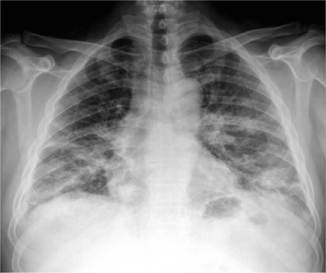 |
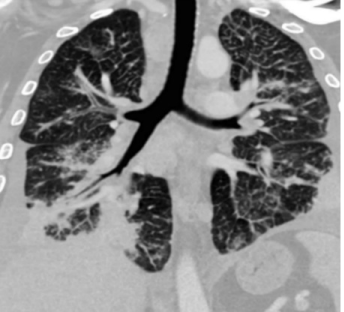 |
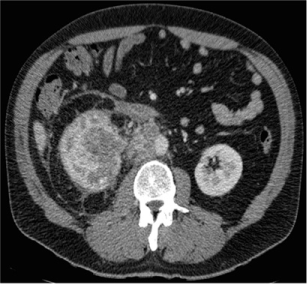 |
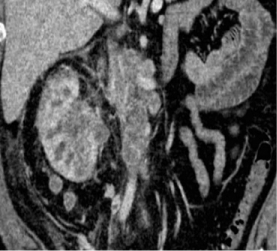 |
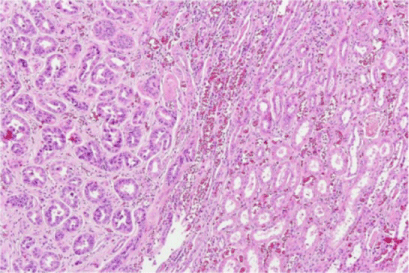 |
| Figure 1 |
Figure 2 |
Figure 3 |
Figure 4 |
Figure 5 |
|
| |
| |










